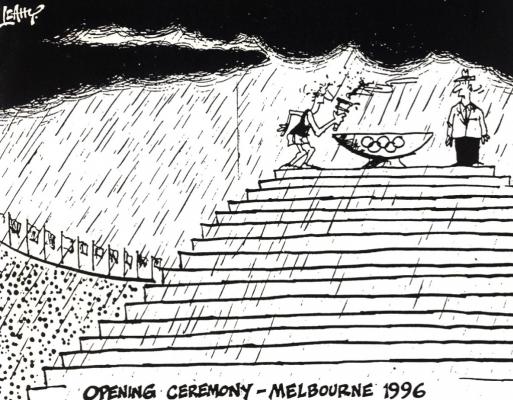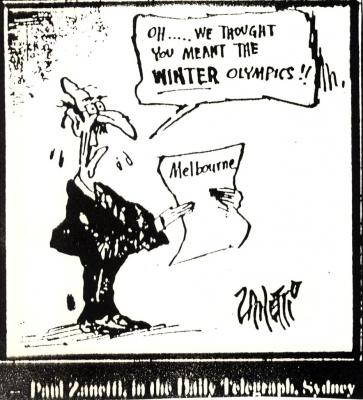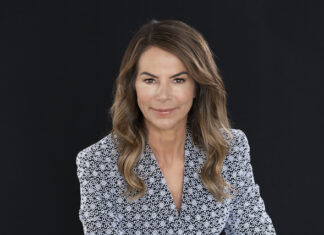
Pride and euphoria abounded in Brisbane in October 1982. Queenslanders and Australians generally felt ‘they’ had done such a brilliant job hosting the XII Commonwealth Games in 1982 that the Lord Mayor of Brisbane Roy Harvey immediately set his sights on the Olympics of 1992.
With his Council’s backing, Harvey formed a project team which outlined proposals for a new international airport, and an arterial road system to link existing and planned sporting venues and accommodation. That done, the Brisbane City Council (BCC) sent a letter to the IOC in January 1983 outlining their intention to bid for the 1992 Games.
The next month Brisbane officials travelled to Lausanne for discussions about the bid process, and in April IOC President Juan Antonio Samaranch, visited Brisbane.
Two years later in June 1985, following changes to the BCC, the newly elected Lord Mayor, Sallyanne Atkinson, attended the 90th Session of the IOC in Berlin in June 1985.
Sallyanne Atkinson was the key proponent of this bid and the impact of her intellect, charm, and political sense on members of the IOC had a vital bearing in the subsequent bids of Melbourne 1996 and Sydney 2000.
The proposed timing of the Brisbane Games produced some interesting arguments. It was suggested that this ‘Olympics Down Under’ would be held between 25 July and 9 August when Brisbane enjoys ‘idyllic dry weather’. This would be beneficial to northern hemisphere athletes because they would compete ‘in-season’.
There was, in addition, the regular refrain that only one Olympic Games had been held in the southern hemisphere – ‘’surely to further the Olympic ideals in Oceania, and throughout the world, it is time to hold another”.
The catch-cry, ‘Brisbane’s Ready’ featured prominently in a video-presentation. It was argued that most of the venues were already in place, and the plans for the remainder had been finalised when the bid was presented in Lausanne in October 1986. The Brisbane bid organisers were sufficiently confident in the progress of their preparations that they were even ready to take over in 1988 following rumours that the preparations for the Seoul Olympics were ‘tardy’ and the Games there might falter.
Brisbane, like any other bid city, had its critics as well. There were many who were scathing of Brisbane’s presumption to bid. Murray Hedgcock wrote in the Weekend Australian in 1984: “It’s difficult to know whether to applaud, laugh, or cry about
Brisbane’s belated campaign to grab the 1992 Summer Olympics … The last thing they [the European countries] want … is to face a 1992 trek to the other side of the world and also be asked to compete out of season because Australia’s summer is Europe’s winter.”
Hedgcock concluded this article with an unkind yet prophetic remark: “He (IOC President, Samaranch) can hardly be blamed for seeking to round off his term of office by persuading his fellows that Spain is ready’’. Barcelona, in Catalonia, Spain, was awarded the 1992 Olympic Games, but Samaranch continued as IOC President.
Brisbane came third. Immediately after the announcement in Lausanne, representatives of the Australian media asked Sallyanne whether Brisbane would bid again for 1996. Aware of the imminence of council elections, she responded that she would have to ask the people of Brisbane.
In my opinion, it was the ‘delay’ by Brisbane which provided the opportunity for Sydney and Melbourne to make a running as the Australian city to bid for the 1996 Games.
John Coates, Executive Director he executive director of the Brisbane Olympic Project Office for the 1992 bid, was interviewed soon after his return to Australia. He said he had little doubt that the AOF again would endorse Brisbane as Australia’s 1996 candidate if it wanted to resubmit. “Climatically, Brisbane is by far our best candidate. For a Sydney Games, you would be looking at October, and November for Melbourne, which is far too late for the northern hemisphere countries.”
Four Australian cities – Brisbane, Melbourne, Perth and Sydney – expressed interest in hosting the 1996 Olympics and throughout 1988 an ‘internal’ selection process took place.
Immediately following the decision in Canberra that Melbourne should be the Australian city to bid for the 1996 Olympics, Sallyanne Atkinson said quietly to her ‘bidding team’ group’ (of which I was a member): “I accept the umpire’s decision, I just think the umpire was wrong”. The next day, ‘Leahy’, cartoonist for the Courier Mail in Brisbane, depicted a frustrated Torch-bearer attempting to kindle the Olympic Flame – in pouring rain.
‘Zanetti’, Sydney’s Daily Telegraph cartoonist, expressed a similar disappointment that Melbourne was chosen by the AOC with the caption, “We thought we were bidding for the Winter Olympics’.
Similar sentiments abounded throughout Australia over the next few years, but especially in Victoria when the IOC in September 1990 announced that Atlanta would host the 1996 Olympics. One of the slogans used by the Melbourne Olympic Committee was that it was ‘Time for Another Continent’. Not only had the northern hemisphere hosted all Summer Olympics apart from 1956, North America had hosted five.
Many IOC members and representatives from international sports federations who visited Melbourne were encouraging in their comments; this was evident in their formal reports, in the media, and in more informal comments to particular individuals, including me.
David Miller, a respected journalist who specialises in writing about the Olympic Movement, supported Melbourne’s case for hosting the Olympics in a London Times article which was reproduced in November 1989 in the Weekend Australian under the headline, ‘Clean, free, safe … and morally justified’:
“Members of the IOC arriving in Melbourne to inspect Australia’s bid for the 1996 Games can stand at the top of the Rialto Tower and see, with a single sweep of the eye, the venues for every sport, bar two. Those two, rowing and canoeing, will be 32 km distant … everything else, except equestrianism and archery at the glorious parkland of
Werribee – just beyond the city – is contained inside a 10 km radius.” 57
Miller was also impressed with specific venues and the Olympic Museum situated at the MCG, which was ‘without equivalent’. He also quoted opinion polls which indicated public support running at 85 per cent.
Although the sentimental favourite was Athens – to celebrate the centenary of the inaugural modern Olympic Games of 1896 – Melbourne was a most worthy contender. Alas, in Tokyo in September 1990, the hopes of Melbourne’s Olympic Flame being kindled in 1996 were doused again when yet another North American city, Atlanta, was elected – assisted greatly by the promise of extensive funding from its ‘home-based’ Coca-Cola company.
However, the formal bids by the AOC for the 1992 Brisbane and 1996 Melbourne Olympic Games set the scene for the successful Sydney 2000 bid, which shall be outlined next week.
[Ian Jobling is Honorary Director of the Centre of Olympic Studies at the University of Queensland]










